fuel cap TOYOTA HIGHLANDER 2008 XU40 / 2.G Owners Manual
[x] Cancel search | Manufacturer: TOYOTA, Model Year: 2008, Model line: HIGHLANDER, Model: TOYOTA HIGHLANDER 2008 XU40 / 2.GPages: 577, PDF Size: 11.46 MB
Page 2 of 577

TABLE OF CONTENTSIndex
2
1-1. Key information .................. 30Keys ..................................... 30
1-2. Opening, closing and locking the doors ............. 32
Smart key system................. 32
Wireless remote control ....... 53
Side doors ............................ 64
Back door ............................. 68
Glass hatch .......................... 73
1-3. Adjustable components (seats, mirrors,
steering wheel) ................. 75
Front seats ........................... 75
Rear seats ............................ 78
Head restraints ..................... 87
Seat belts ............................. 90
Steering wheel ..................... 96
Anti-glare inside rear view mirror .................................. 97
Outside rear view mirrors ..... 99
1-4. Opening and closing the windows and
moon roof ....................... 101
Power windows .................. 101
Moon roof ........................... 103
1-5. Refueling ........................... 106 Opening the fuel tank cap ................................... 106 1-6. Theft deterrent
system ............................. 110
Engine immobilizer system .............................. 110
Alarm .................................. 116
Theft prevention labels (U.S.A.)............................. 119
1-7. Safety information ............ 120 Correct driving posture ....... 120
SRS airbags ....................... 122
Front passenger occupant classification system ......... 134
Child restraint systems ....... 140
Installing child restraints ..... 144
2-1. Driving procedures........... 156 Driving the vehicle .............. 156
Engine (ignition) switch (vehicles with smart key
system) ............................. 164
Engine (ignition) switch (vehicles without smart
key system) ...................... 168
Automatic Transmission ..... 171
Turn signal lever ................. 175
Parking brake ..................... 176
2-2. Instrument cluster ............ 177 Gauges and meters ............ 177
Indicators and warning lights ................................. 179
Multi-information display ..... 183
1Before driving
2When driving
Page 29 of 577
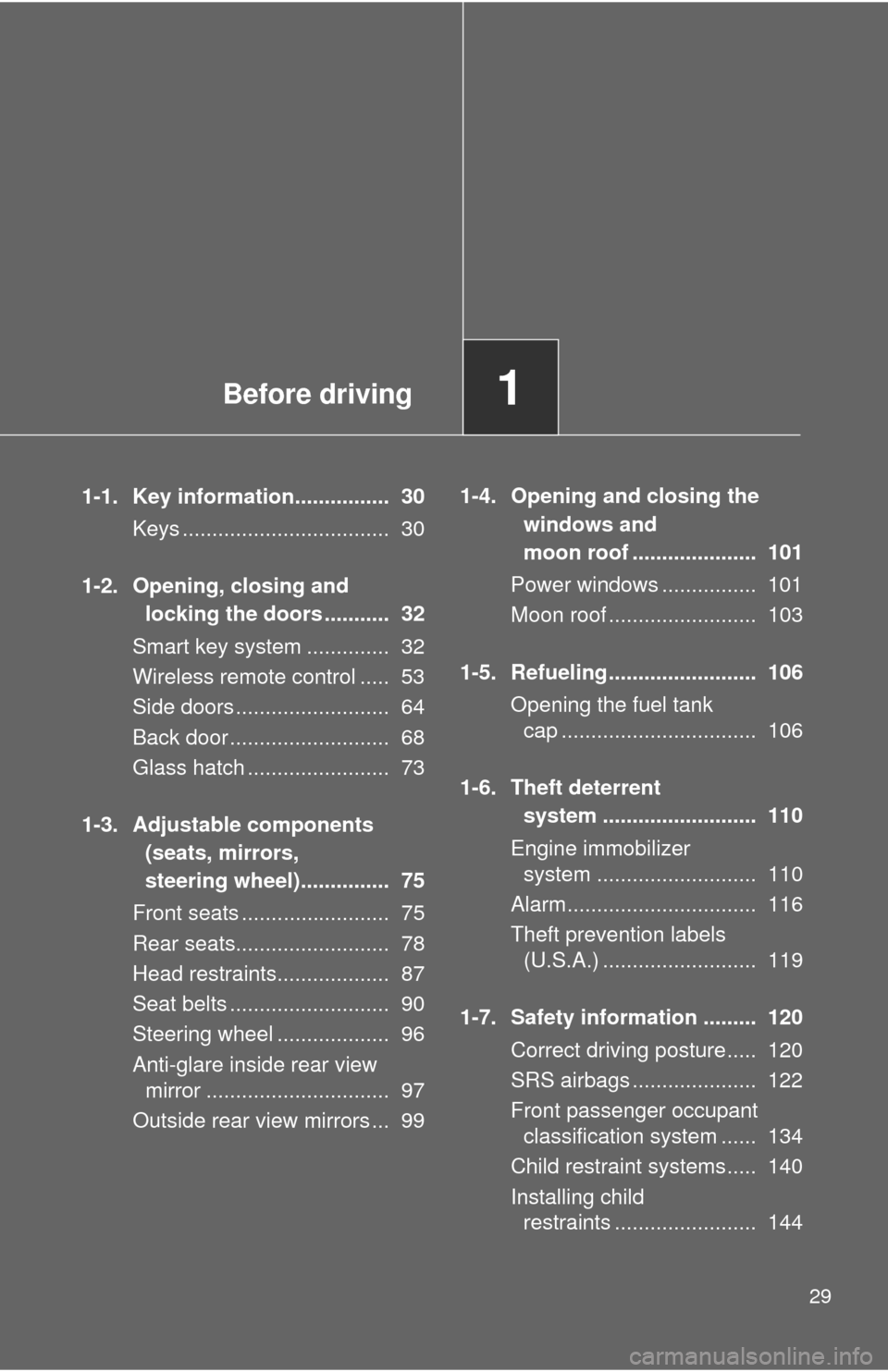
Before driving1
29
1-1. Key information................ 30Keys ................................... 30
1-2. Opening, closing and locking the doors ........... 32
Smart key system .............. 32
Wireless remote control ..... 53
Side doors .......................... 64
Back door ........................... 68
Glass hatch ........................ 73
1-3. Adjustable components (seats, mirrors,
steering wheel)............... 75
Front seats ......................... 75
Rear seats.......................... 78
Head restraints................... 87
Seat belts ........................... 90
Steering wheel ................... 96
Anti-glare inside rear view mirror ............................... 97
Outside rear view mirrors ... 99 1-4. Opening and closing the
windows and
moon roof ..................... 101
Power windows ................ 101
Moon roof ......................... 103
1-5. Refueling......................... 106 Opening the fuel tank cap ................................. 106
1-6. Theft deterrent system .......................... 110
Engine immobilizer system ........................... 110
Alarm................................ 116
Theft prevention labels (U.S.A.) .......................... 119
1-7. Safety information ......... 120 Correct driving posture..... 120
SRS airbags ..................... 122
Front passenger occupant classification system ...... 134
Child restraint systems..... 140
Installing child restraints ........................ 144
Page 106 of 577
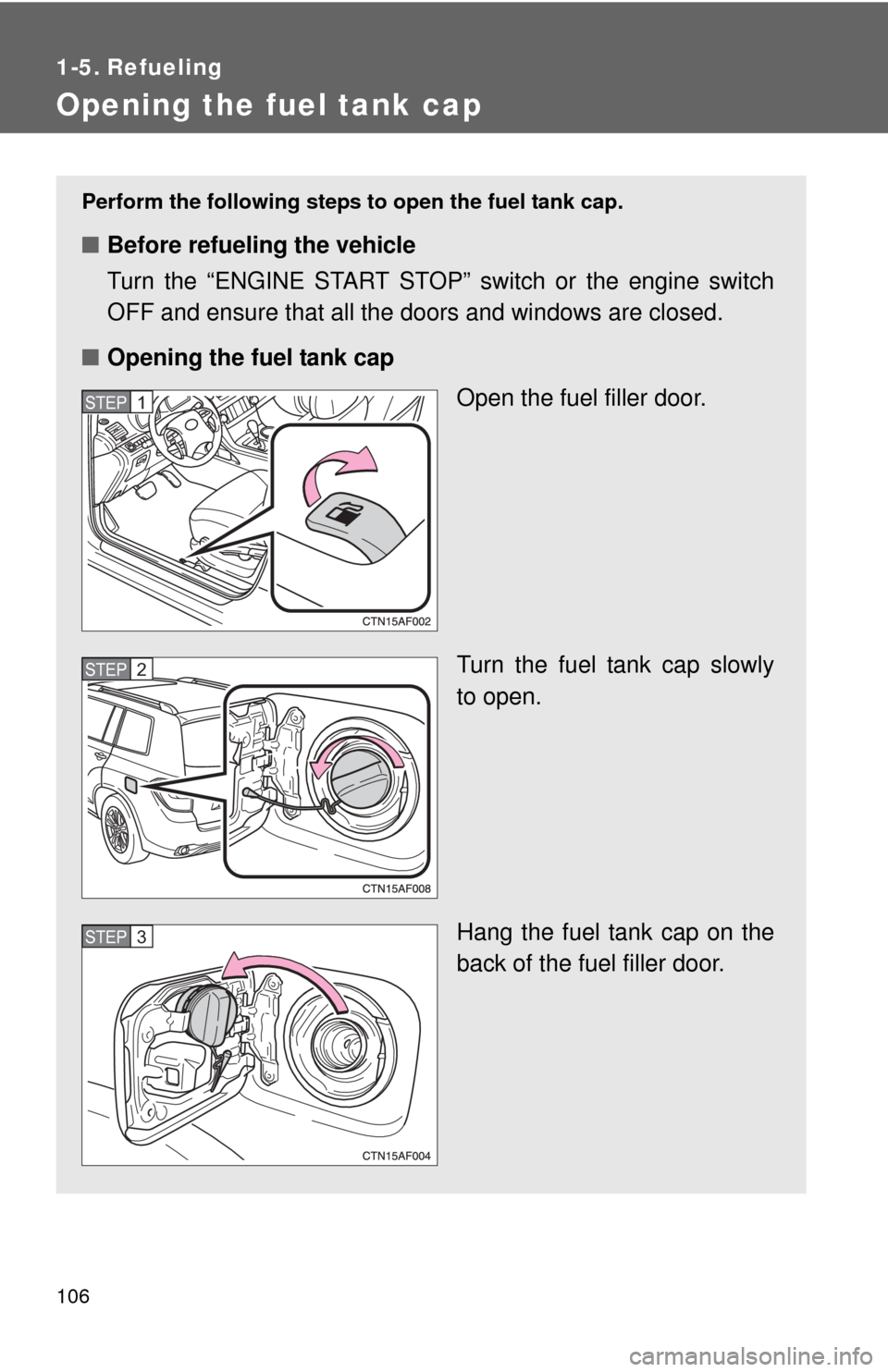
106
1-5. Refueling
Opening the fuel tank cap
Perform the following steps to open the fuel tank cap.
■Before refueling the vehicle
Turn the “ENGINE START STOP” switch or the engine switch
OFF and ensure that all the doors and windows are closed.
■ Opening the fuel tank cap
Open the fuel filler door.
Turn the fuel tank cap slowly
to open.
Hang the fuel tank cap on the
back of the fuel filler door.
STEP1
STEP2
STEP3
Page 107 of 577
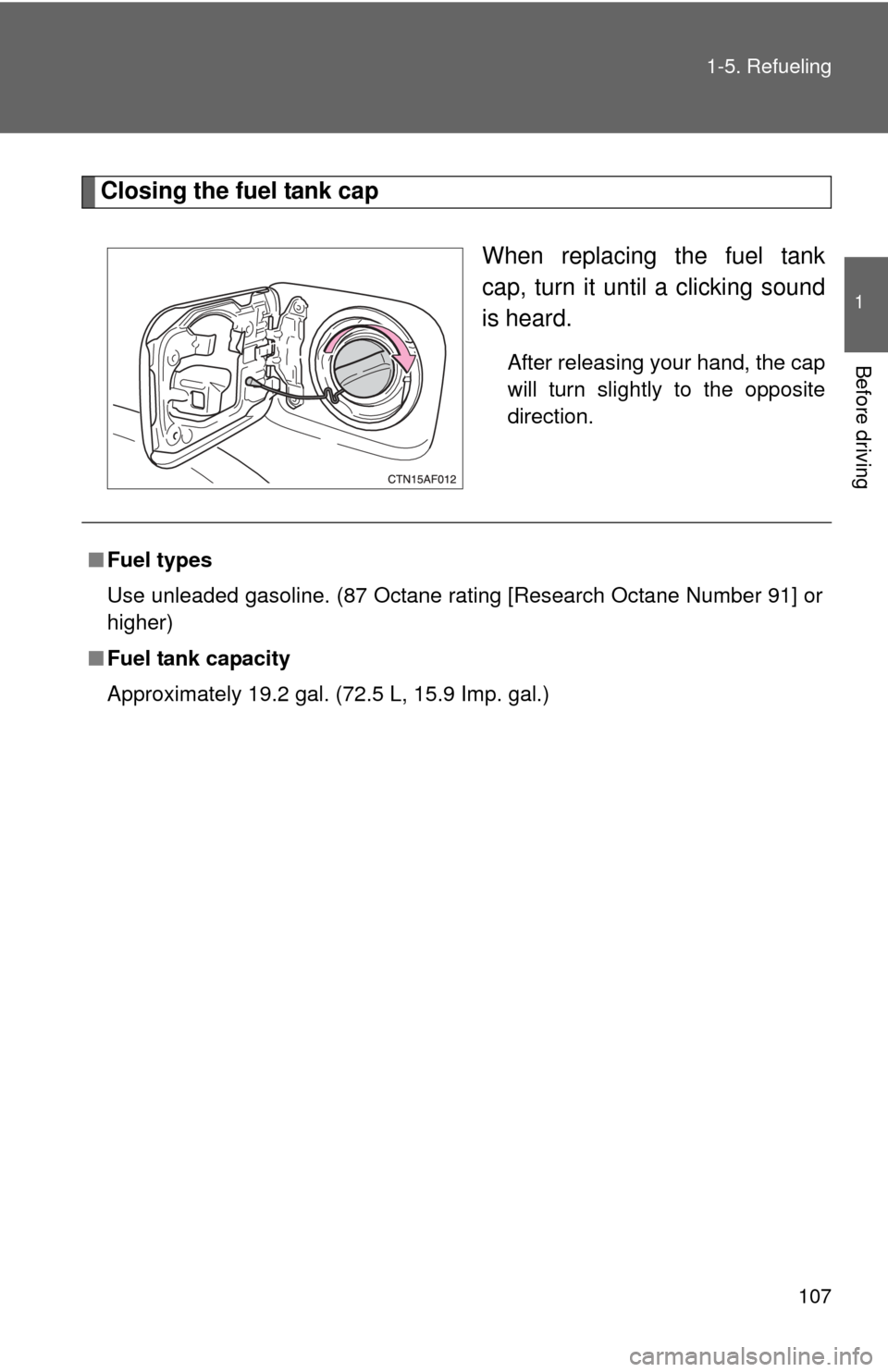
107
1-5. Refueling
1
Before driving
Closing the fuel tank cap
When replacing the fuel tank
cap, turn it until a clicking sound
is heard.
After releasing your hand, the cap
will turn slightly to the opposite
direction.
■Fuel types
Use unleaded gasoline. (87 Octane rating [Research Octane Number 91] or
higher)
■ Fuel tank capacity
Approximately 19.2 gal. (72.5 L, 15.9 Imp. gal.)
Page 108 of 577
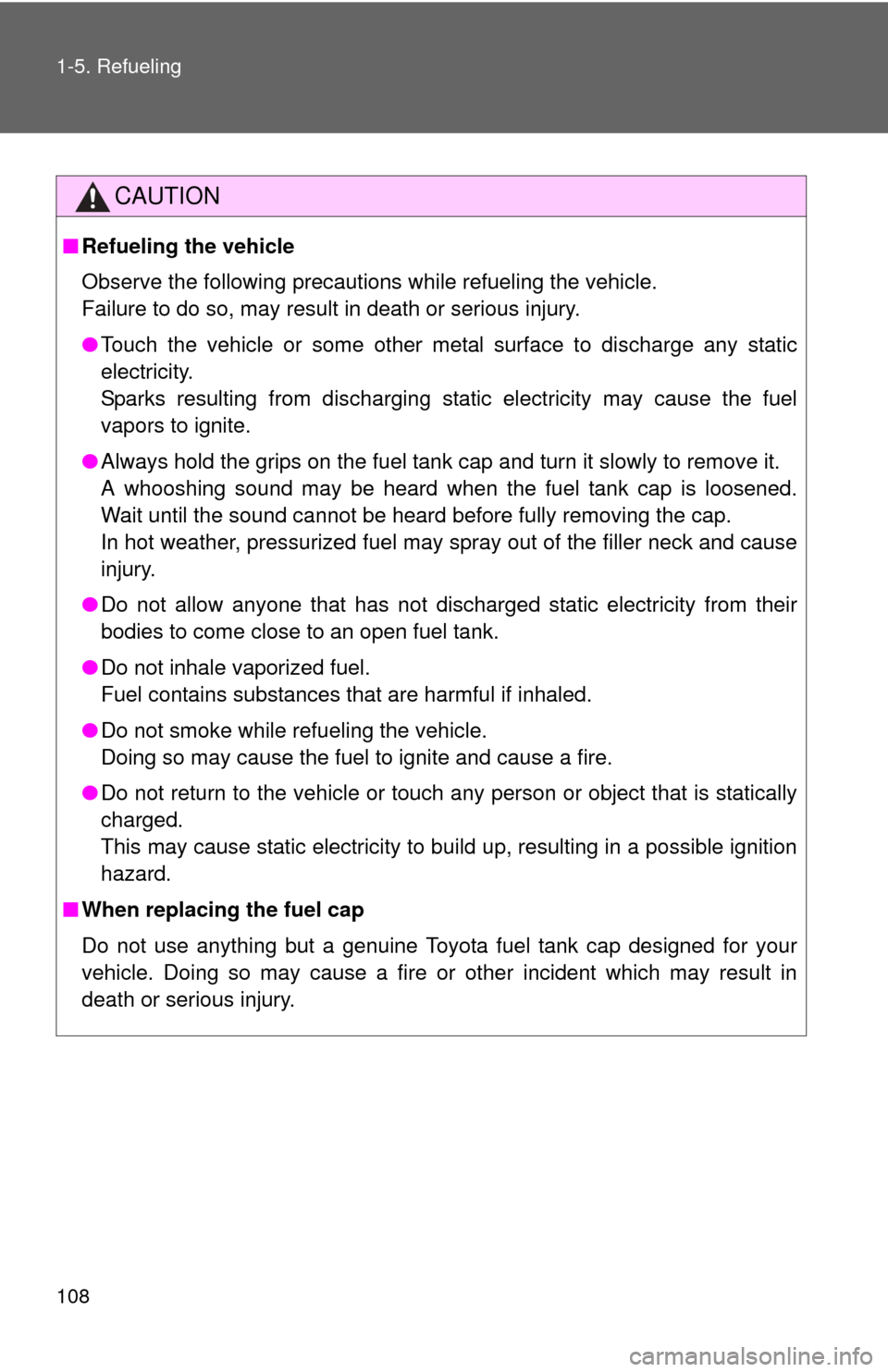
108 1-5. Refueling
CAUTION
■Refueling the vehicle
Observe the following precautions while refueling the vehicle.
Failure to do so, may result in death or serious injury.
●Touch the vehicle or some other metal surface to discharge any static
electricity.
Sparks resulting from discharging static electricity may cause the fuel
vapors to ignite.
● Always hold the grips on the fuel tank cap and turn it slowly to remove it.
A whooshing sound may be heard when the fuel tank cap is loosened.
Wait until the sound cannot be heard before fully removing the cap.
In hot weather, pressurized fuel may spray out of the filler neck and cause
injury.
● Do not allow anyone that has not discharged static electricity from their
bodies to come close to an open fuel tank.
● Do not inhale vaporized fuel.
Fuel contains substances that are harmful if inhaled.
● Do not smoke while refueling the vehicle.
Doing so may cause the fuel to ignite and cause a fire.
● Do not return to the vehicle or touch any person or object that is statically
charged.
This may cause static electricity to build up, resulting in a possible ignition
hazard.
■ When replacing the fuel cap
Do not use anything but a genuine Toyota fuel tank cap designed for your
vehicle. Doing so may cause a fire or other incident which may result in
death or serious injury.
Page 220 of 577
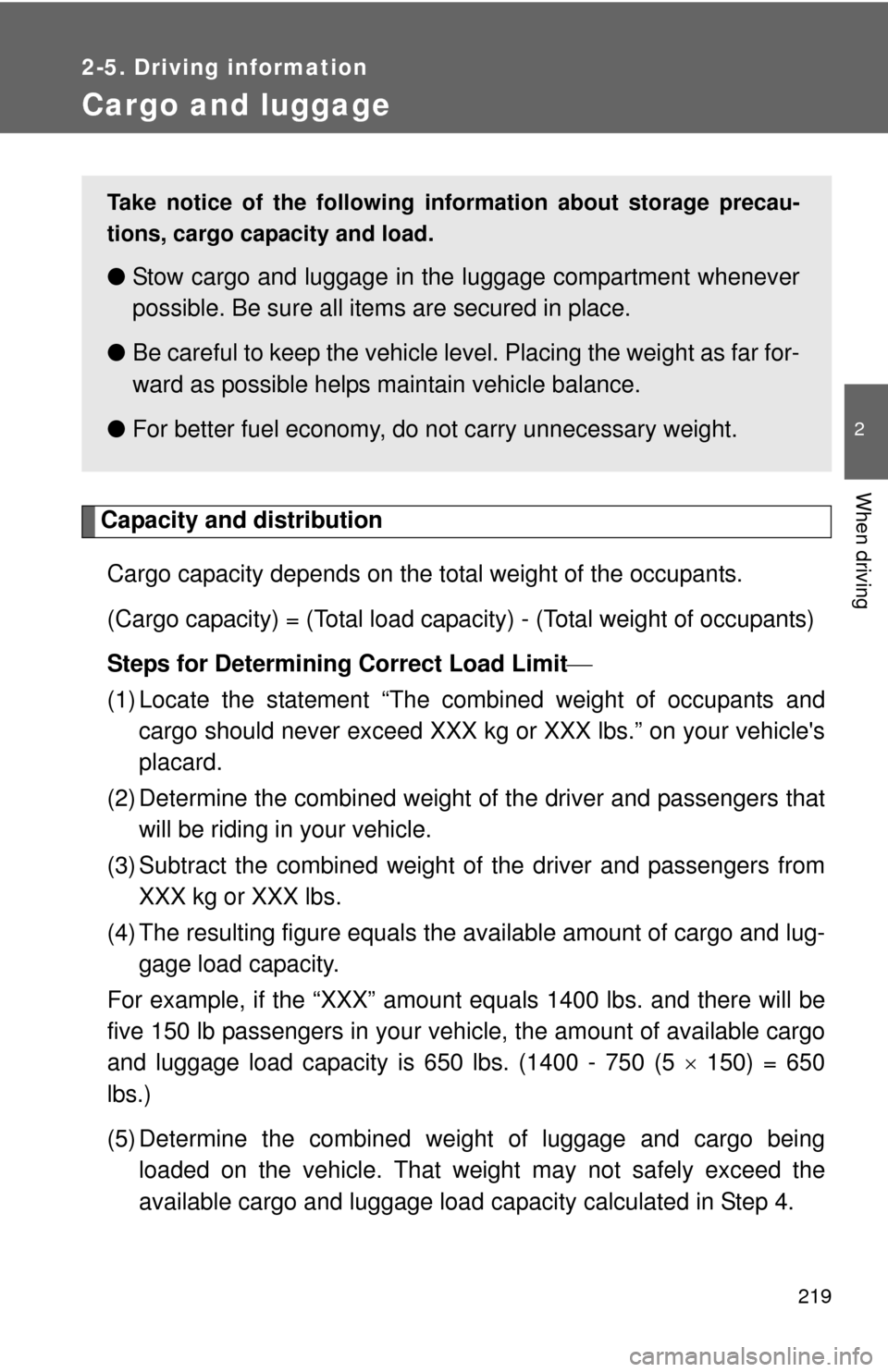
219
2-5. Driving information
2
When driving
Cargo and luggage
Capacity and distributionCargo capacity depends on the total weight of the occupants.
(Cargo capacity) = (Total load capacity) - (Total weight of occupants)
Steps for Determining Correct Load Limit
(1) Locate the statement “The co mbined weight of occupants and
cargo should never exceed XXX kg or XXX lbs.” on your vehicle's
placard.
(2) Determine the combined weight of the driver and passengers that will be riding in your vehicle.
(3) Subtract the combined weight of the driver and passengers from XXX kg or XXX lbs.
(4) The resulting figure equals the av ailable amount of cargo and lug-
gage load capacity.
For example, if the “XXX” amount equals 1400 lbs. and there will be
five 150 lb passengers in your vehicle, the amount of available cargo
and luggage load capacity is 650 lbs. (1400 - 750 (5 150) = 650
lbs.)
(5) Determine the combined weight of luggage and cargo being loaded on the vehicle. That weight may not safely exceed the
available cargo and luggage load capacity calculated in Step 4.
Take notice of the following information about storage precau-
tions, cargo capacity and load.
●Stow cargo and luggage in the luggage compartment whenever
possible. Be sure all item s are secured in place.
● Be careful to keep the vehicle level. Placing the weight as far for-
ward as possible helps maintain vehicle balance.
● For better fuel economy, do no t carry unnecessary weight.
Page 410 of 577
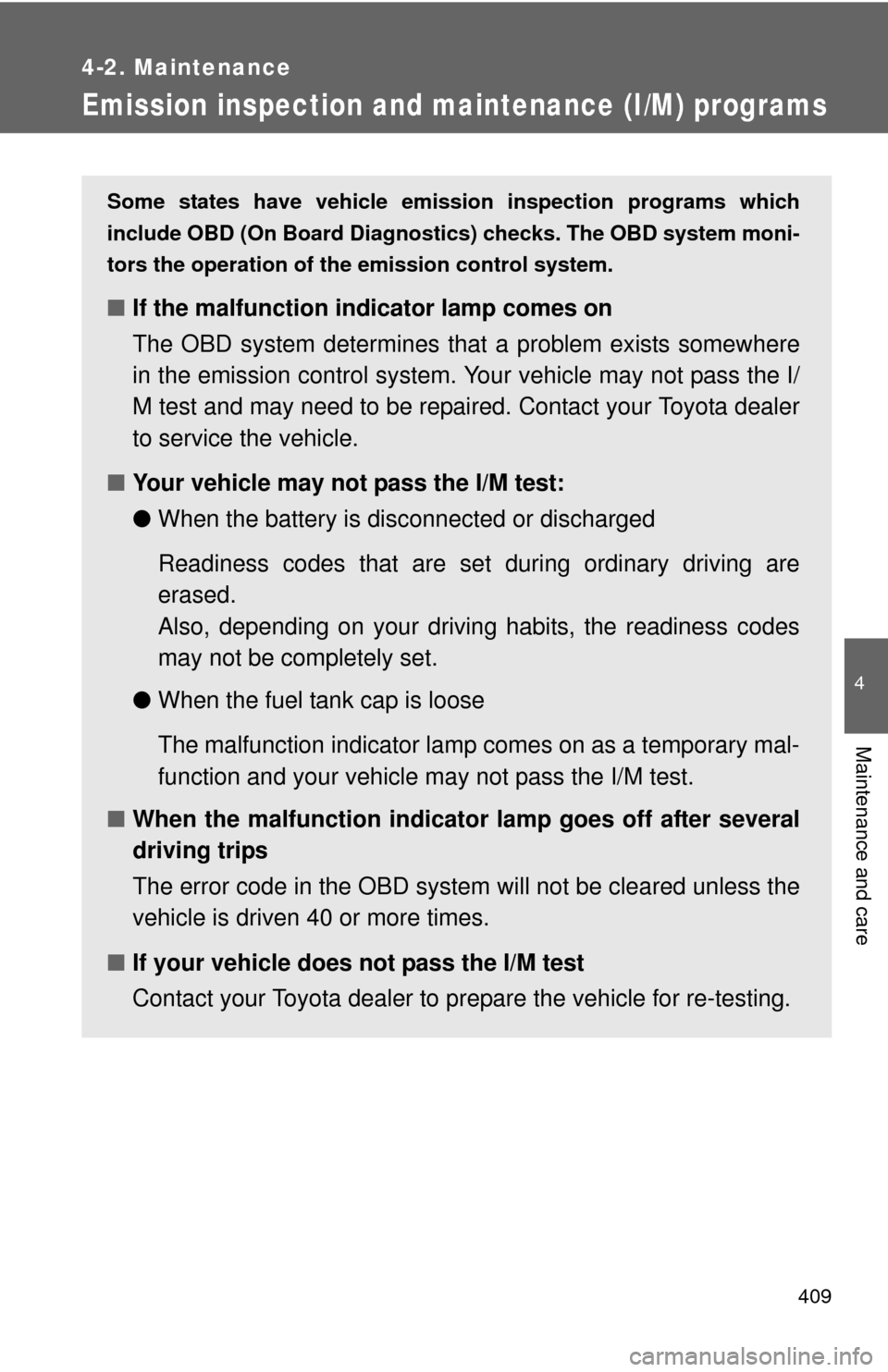
409
4-2. Maintenance
4
Maintenance and care
Emission inspection and maintenance (I/M) programs
Some states have vehicle emission inspection programs which
include OBD (On Board Diagnostics) checks. The OBD system moni-
tors the operation of th e emission control system.
■If the malfunction indicator lamp comes on
The OBD system determines that a problem exists somewhere
in the emission control system. Your vehicle may not pass the I/
M test and may need to be repaired. Contact your Toyota dealer
to service the vehicle.
■ Your vehicle may not pass the I/M test:
●When the battery is disconnected or discharged
Readiness codes that are se t during ordinary driving are
erased.
Also, depending on your driving habits, the readiness codes
may not be completely set.
● When the fuel tank cap is loose
The malfunction indicator lamp comes on as a temporary mal-
function and your vehicle may not pass the I/M test.
■ When the malfunction indicator lamp goes off after several
driving trips
The error code in the OBD system will not be cleared unless the
vehicle is driven 40 or more times.
■ If your vehicle does not pass the I/M test
Contact your Toyota dealer to prepare the vehicle for re-testing.
Page 446 of 577
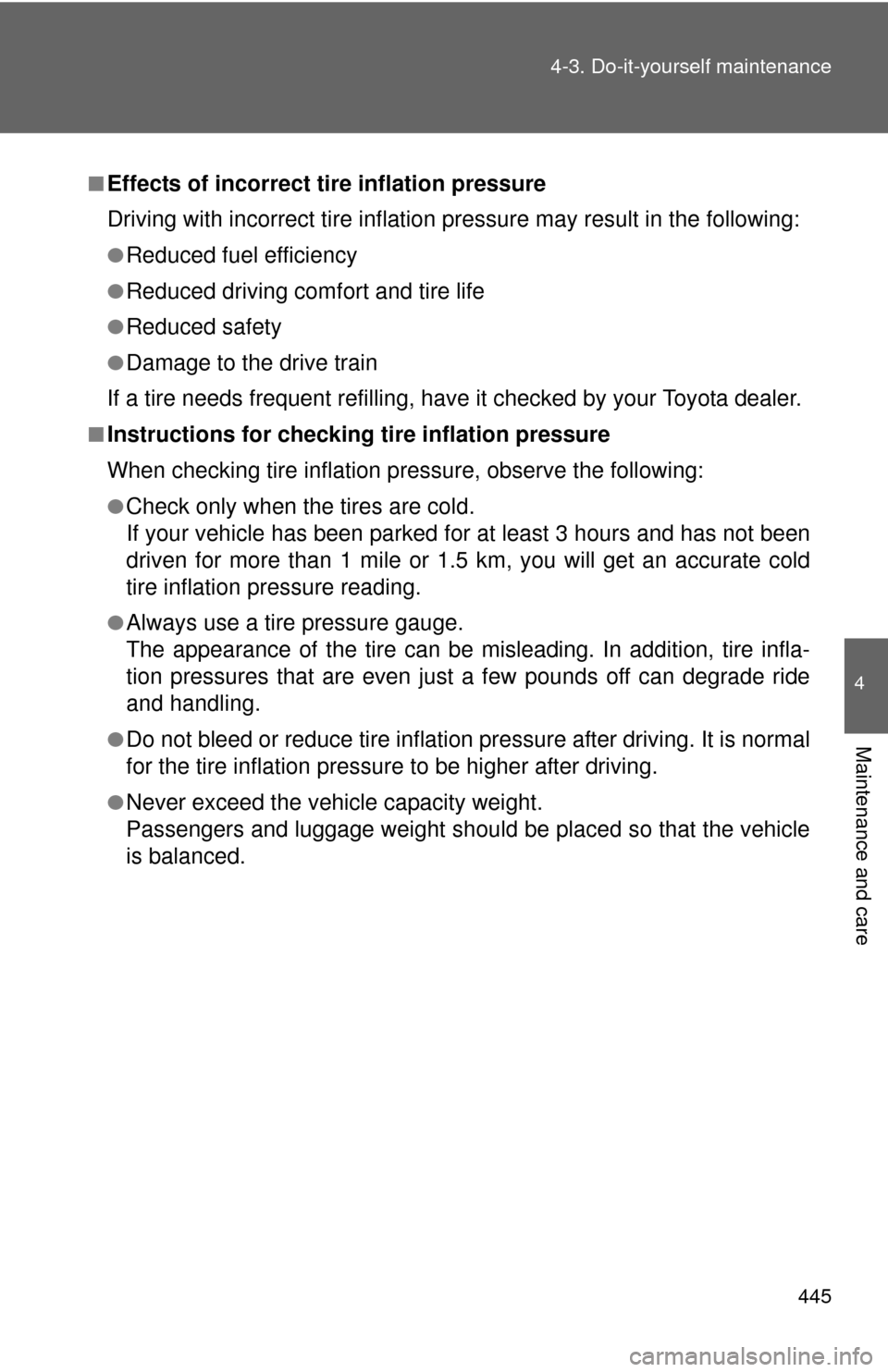
445
4-3. Do-it-yourself maintenance
4
Maintenance and care
■Effects of incorrect tire inflation pressure
Driving with incorrect ti
re inflation pressure ma y result in the following:
●Reduced fuel efficiency
●Reduced driving comfort and tire life
●Reduced safety
●Damage to the drive train
If a tire needs frequent re filling, have it checked by your Toyota dealer.
■Instructions for checking tire inflation pressure
When checking tire inflation pressure, observe the following:
●Check only when the tires are cold.
If your vehicle has been parked for at least 3 hours and has not been
driven for more than 1 mile or 1.5 km, you will get an accurate cold
tire inflation pressure reading.
●Always use a tire pressure gauge.
The appearance of the tire can be mi sleading. In addition, tire infla-
tion pressures that are even just a few pounds off can degrade ride
and handling.
●Do not bleed or reduce tire inflation pressure after driving. It is normal
for the tire inflation pressure to be higher after driving.
●Never exceed the vehicle capacity weight.
Passengers and luggage weight should be placed so that the vehicle
is balanced.
Page 492 of 577
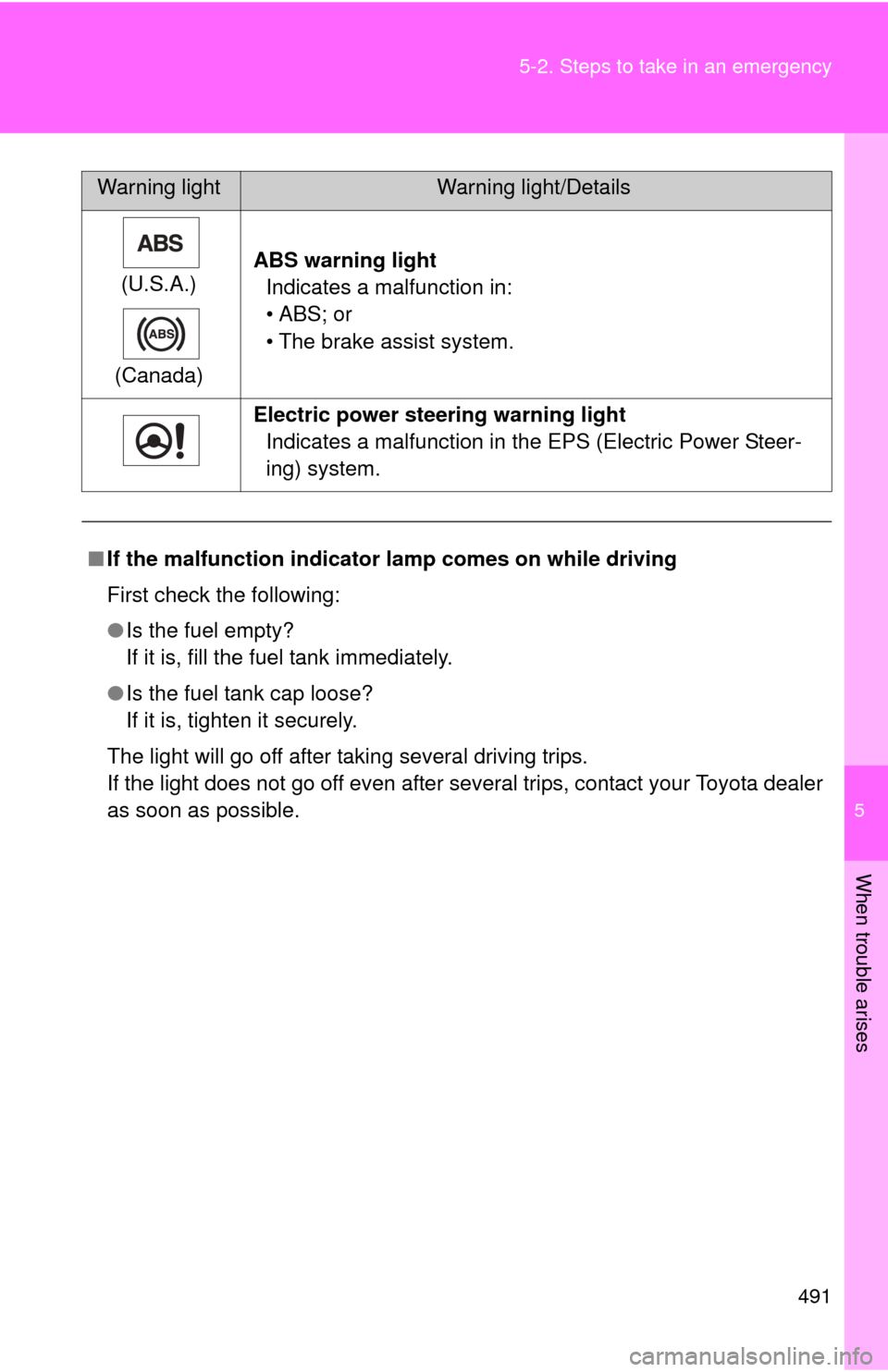
5
When trouble arises
491
5-2. Steps to take in an emergency
(U.S.A.)
(Canada) ABS warning light
Indicates a malfunction in:
•ABS; or
• The brake assist system.
Electric power steering warning light Indicates a malfunction in the EPS (Electric Power Steer-
ing) system.
■ If the malfunction indicator lamp comes on while driving
First check the following:
● Is the fuel empty?
If it is, fill the fuel tank immediately.
● Is the fuel tank cap loose?
If it is, tighten it securely.
The light will go off after taking several driving trips.
If the light does not go off even after several trips, contact your Toyota dealer
as soon as possible.
Warning lightWarning light/Details
Page 527 of 577
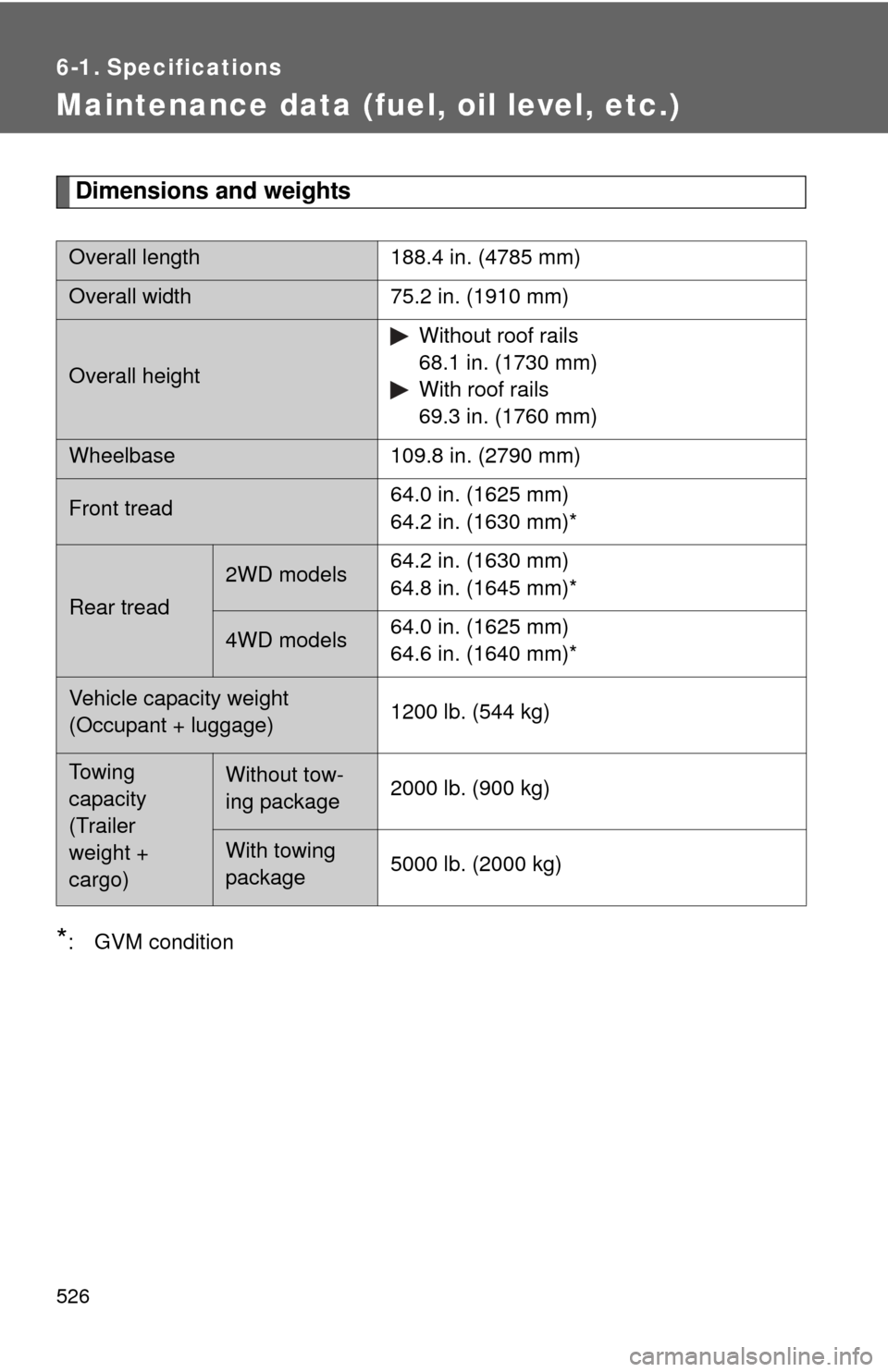
526
6-1. Specifications
Maintenance data (fuel, oil level, etc.)
Dimensions and weights
*: GVM condition
Overall length188.4 in. (4785 mm)
Overall width75.2 in. (1910 mm)
Overall height Without roof rails
68.1 in. (1730 mm)
With roof rails
69.3 in. (1760 mm)
Wheelbase
109.8 in. (2790 mm)
Front tread 64.0 in. (1625 mm)
64.2 in. (1630 mm)*
Rear tread
2WD models64.2 in. (1630 mm)
64.8 in. (1645 mm)*
4WD models64.0 in. (1625 mm)
64.6 in. (1640 mm)*
Vehicle capacity weight
(Occupant + luggage) 1200 lb. (544 kg)
Towing
capacity
(Trailer
weight +
cargo)Without tow-
ing package2000 lb. (900 kg)
With towing
package5000 lb. (2000 kg)